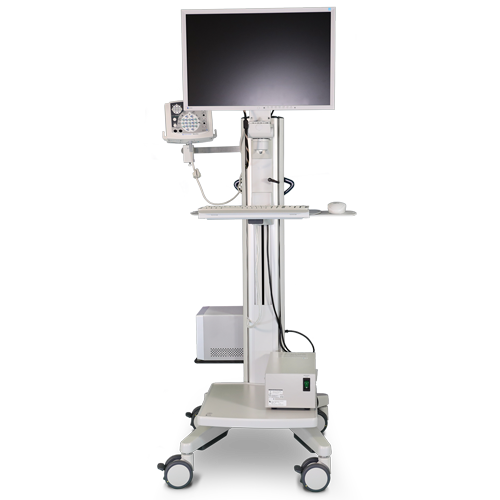

Neuromonitoraggio (ICU)
Sta cercando informazioni su un prodotto specifico? Si prega di notare che questo sito web è ancora in fase di traduzione e alcuni contenuti potrebbero apparire nella lingua originale. Stiamo lavorando per completare le traduzioni e apprezziamo la vostra comprensione.
Neuromonitoraggio in terapia intensiva
Il monitoraggio cardiaco e respiratorio sono pratiche standard nell’ambiente dell’unità di terapia intensiva (ICU) oggi, tuttavia, l’elettroencefalografia (EEG), che svolge un ruolo cruciale nel determinare lo stato attuale del paziente, non lo è. Nonostante le sfide associate al monitoraggio continuo dell’EEG (cEEG) in ICU, durante questa fase cruciale della cura del paziente, Nihon Kohden offre molteplici soluzioni per la misurazione del cEEG.
Il nostro innovativo sistema EEG wireless (CerebAir) consente una preparazione e una misurazione semplificate, consentendo una più rapida acquisizione dell’EEG e un monitoraggio a lungo termine. I clinici sono meglio supportati con algoritmi di rilevamento delle crisi abilitati nel trend software con testina a 38 canali, consentendo l’identificazione rapida dell’attività delle crisi e quindi un intervento clinico più rapido per il paziente. Il monitoraggio semplificato dell’EEG è disponibile con moduli sui monitor dei pazienti Nihon Kohden, consentendo la visualizzazione dei dati EEG sulla stazione centrale di cura.
Di conseguenza, il monitoraggio continuo dell’EEG in ICU può diventare un parametro standard per la cura completa del paziente in questo ambiente di terapia intensiva.

Monitoraggio semplificato dell’EEG wireless
Sviluppato per fornire un nuovo standard di cura continua dell’EEG (cEEG) per pazienti incoscienti nel pronto soccorso e in terapia intensiva, il CerebAir è un caschetto EEG wireless a basso numero di canali che può essere rapidamente utilizzato da qualsiasi infermiere/clinico del pronto soccorso o della terapia intensiva e monitorato a distanza da un tecnico o medico EEG.
CerebAir fornisce dati cruciali che consentono al medico della terapia intensiva di valutare correttamente e determinare il miglior corso di trattamento per i pazienti critici, utilizzando le risorse limitate nel modo più efficace possibile.
Rapido
- Il design unico consente l’installazione e l’acquisizione in 5 minuti
Le posizioni fisse degli elettrodi garantiscono un posizionamento efficiente
Il design flessibile consente un’applicazione rapida e facile per qualsiasi dimensione della testa di un paziente adulto

Critico
- L’accesso remoto consente ai medici di valutare rapidamente i pazienti da una posizione remota
Fornisce dati appropriati che possono essere utilizzati per monitorare e valutare la necessità di un intervento intensificato
Assiste i clinici nel prendere decisioni rapide e informate sul corso di cura più appropriato per i pazienti critici

Essenziale
- La comunicazione Bluetooth elimina la necessità di cavi aggiuntivi, risparmiando spazio in un ambiente già affollato
Il design unico degli elettrodi fornisce una registrazione di alta qualità necessaria per i pazienti critici
La visualizzazione dei dati semplificata fornisce ai medici dettagli specifici per l’intervento sui pazienti con compromissione neurologica

Qualità a lungo termine
Soluzione tutto-in-uno: Una scatola di giunzione per EEG continuo (cEEG) fornisce ingressi EEG a 32 canali. Il JE-921A offre la massima qualità del segnale e la massima affidabilità.
Il convertitore della scatola di ingresso QI-123A collega il JE-921A all’EEG tramite una rete LAN. Questo fornisce connettività LAN ed espandibilità per un sistema EEG.
Chiarezza
- Il software di rilevamento delle convulsioni per adulti e neonati assiste medici e infermieri identificando le convulsioni sospette
Consentendo il corso di cura più appropriato per questi pazienti critici

Panoramica
- I dati delle tendenze cliniche appropriate sono resi disponibili con l’uso del software di trend EEG, che può essere utilizzato per monitorare e valutare la necessità di un intervento intensificato
Con l’aggiunta dell’interfaccia dei segni vitali, i dati appropriati dei segni vitali possono essere visualizzati sullo schermo delle tendenze EEG, ottimizzando le informazioni cliniche visualizzate ai medici e consentendo interventi mirati sui pazienti con compromissione neurologica

Supporto
- Il monitoraggio remoto da parte di un tecnico o medico EEG con il pannello di visualizzazione in tempo reale garantisce un supporto specialistico di alto livello al medico della terapia intensiva
Garantisce un supporto specialistico di alto livello al medico della terapia intensiva



